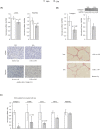Liraglutide improves liver microvascular dysfunction in cirrhosis: Evidence from translational studies
- PMID: 28607430
- PMCID: PMC5468330
- DOI: 10.1038/s41598-017-02866-y
Liraglutide improves liver microvascular dysfunction in cirrhosis: Evidence from translational studies
Abstract
Hepatic stellate cells (HSC) play a key role in the development of chronic liver disease (CLD). Liraglutide, well-established in type 2 diabetes, showed anti-inflammatory and anti-oxidant properties. We evaluated the effects of liraglutide on HSC phenotype and hepatic microvascular function using diverse pre-clinical models of CLD. Human and rat HSC were in vitro treated with liraglutide, or vehicle, and their phenotype, viability and proliferation were evaluated. In addition, liraglutide or vehicle was administered to rats with CLD. Liver microvascular function, fibrosis, HSC phenotype and sinusoidal endothelial phenotype were determined. Additionally, the effects of liraglutide on HSC phenotype were analysed in human precision-cut liver slices. Liraglutide markedly improved HSC phenotype and diminished cell proliferation. Cirrhotic rats receiving liraglutide exhibited significantly improved liver microvascular function, as evidenced by lower portal pressure, improved intrahepatic vascular resistance, and marked ameliorations in fibrosis, HSC phenotype and endothelial function. The anti-fibrotic effects of liraglutide were confirmed in human liver tissue and, although requiring further investigation, its underlying molecular mechanisms suggested a GLP1-R-independent and NF-κB-Sox9-dependent one. This study demonstrates for the first time that liraglutide improves the liver sinusoidal milieu in pre-clinical models of cirrhosis, encouraging its clinical evaluation in the treatment of chronic liver disease.
Conflict of interest statement
The authors declare that they have no competing interests.
Figures




Similar articles
-
Mitochondria-targeted antioxidant mitoquinone deactivates human and rat hepatic stellate cells and reduces portal hypertension in cirrhotic rats.Liver Int. 2017 Jul;37(7):1002-1012. doi: 10.1111/liv.13436. Epub 2017 Apr 27. Liver Int. 2017. PMID: 28371136
-
FXR agonist obeticholic acid reduces hepatic inflammation and fibrosis in a rat model of toxic cirrhosis.Sci Rep. 2016 Sep 16;6:33453. doi: 10.1038/srep33453. Sci Rep. 2016. PMID: 27634375 Free PMC article.
-
KLF2 exerts antifibrotic and vasoprotective effects in cirrhotic rat livers: behind the molecular mechanisms of statins.Gut. 2015 Sep;64(9):1434-43. doi: 10.1136/gutjnl-2014-308338. Epub 2014 Dec 10. Gut. 2015. PMID: 25500203
-
New cellular and molecular targets for the treatment of portal hypertension.Hepatol Int. 2015 Apr;9(2):183-91. doi: 10.1007/s12072-015-9613-5. Epub 2015 Mar 5. Hepatol Int. 2015. PMID: 25788198 Review.
-
Intrahepatic angiogenesis and sinusoidal remodeling in chronic liver disease: new targets for the treatment of portal hypertension?J Hepatol. 2010 Nov;53(5):976-80. doi: 10.1016/j.jhep.2010.07.004. Epub 2010 Jul 24. J Hepatol. 2010. PMID: 20800926 Review.
Cited by
-
Emerging Therapeutic Targets for Portal Hypertension.Curr Hepatol Rep. 2023;22(1):51-66. doi: 10.1007/s11901-023-00598-4. Epub 2023 Feb 11. Curr Hepatol Rep. 2023. PMID: 36908849 Free PMC article. Review.
-
Nuclear deformation mediates liver cell mechanosensing in cirrhosis.JHEP Rep. 2020 Jul 17;2(5):100145. doi: 10.1016/j.jhepr.2020.100145. eCollection 2020 Oct. JHEP Rep. 2020. PMID: 32939447 Free PMC article.
-
The progress to establish optimal animal models for the study of acute-on-chronic liver failure.Front Med (Lausanne). 2023 Feb 9;10:1087274. doi: 10.3389/fmed.2023.1087274. eCollection 2023. Front Med (Lausanne). 2023. PMID: 36844207 Free PMC article. Review.
-
Aging Influences Hepatic Microvascular Biology and Liver Fibrosis in Advanced Chronic Liver Disease.Aging Dis. 2019 Aug 1;10(4):684-698. doi: 10.14336/AD.2019.0127. eCollection 2019 Aug. Aging Dis. 2019. PMID: 31440376 Free PMC article.
-
Challenges of in vitro modelling of liver fibrosis.Front Cell Dev Biol. 2025 Apr 30;13:1567916. doi: 10.3389/fcell.2025.1567916. eCollection 2025. Front Cell Dev Biol. 2025. PMID: 40371390 Free PMC article. Review.
References
Publication types
MeSH terms
Substances
LinkOut - more resources
Full Text Sources
Other Literature Sources
Medical
Research Materials

